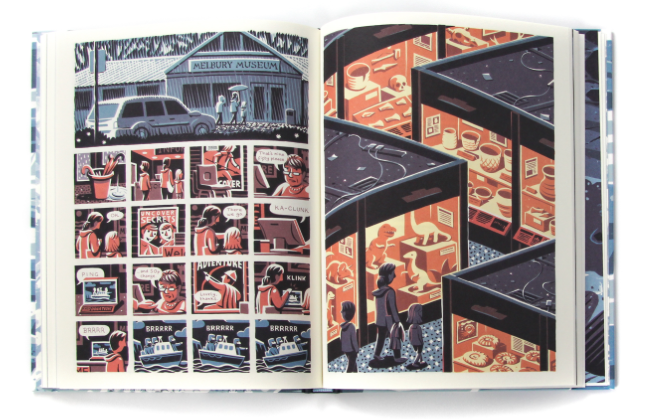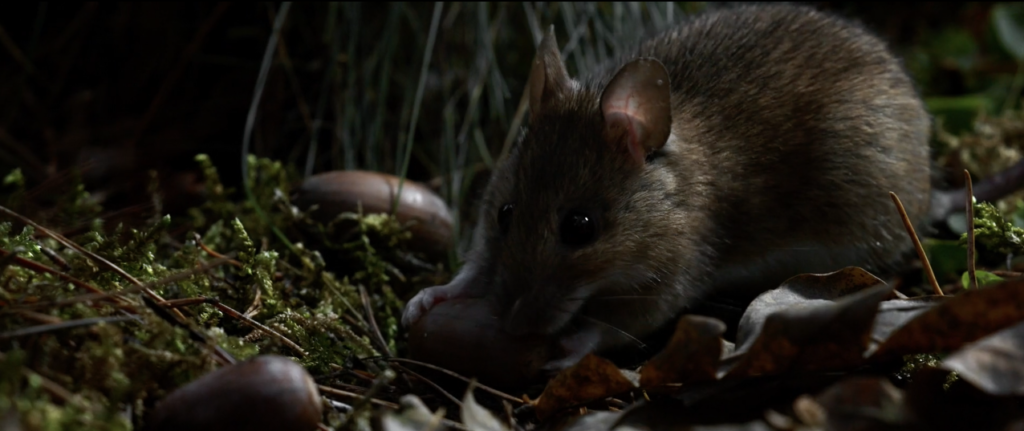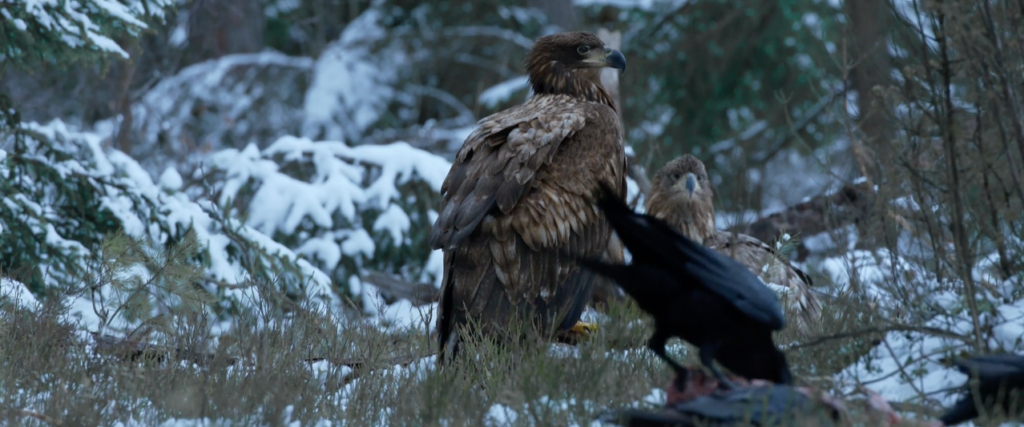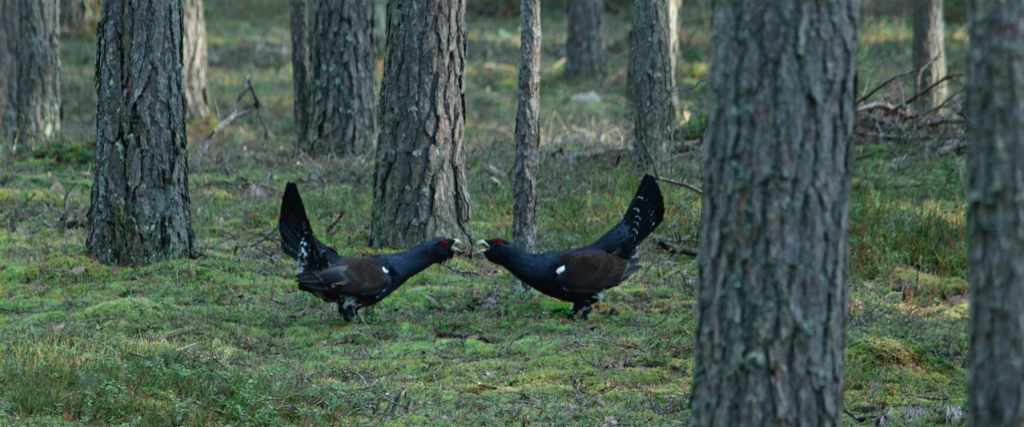Tim Dee muses on two documents of modern nature; Jon McNaught’s graphic novel ‘Kingdom’ and Mindaugus Survila’s film ‘The Ancient Woods’

Two new documents of modern nature crossed my desk in one week. They are very different but the accident of their simultaneous arrival threw them together and, perhaps, indeed, they can be put into a fruitful conversation with one another.
One is a comic and the other a film. Both use the technology of close-ups and magnification to tell their stories. Both record ways of seeing and both are closely observed accounts of how things go vis-a-vis the remnants of the wild in contemporary Europe. Both are interested in clocking the passing of time as it plays out in nature and across human lives. Both describe how wildlife survives alongside us. The odd, old tang of that term – wildlife – might alert us, as well, to a shared concern in both these productions. How does the wild still exist for us in our world? What meaning comes off it for us today? Both comic and film direct their viewers to emotional responses about this. One is terrifically depressing – the other exhilaratingly alive. Both seem true to life.

In a sombre, limited and matt palette of grey-blues and pinkish-reds, Jon McNaught’s comic Kingdom tells the story of a mother and her two children (Andy and Suzie, young teenagers or thereabouts) going on a generic British seaside holiday. It is generic not because McNaught has no imagination but because he draws what he sees and what he knows to be the case. To live in England nowadays (I use the word to mean England not the British Isles) is mostly to be an inhabitant of a non-place. In the comic, the family travel crowded motorways to get to a caravan park. They stop at a services. They eat fast food. They watch TV and their phones. They shoot pixels on screens. The plasticated and digitised noises the artificial world has added to our soundtrack dog them wherever they go. (I think there is a knowing joke here: the old comic-book sounds, which stood in for the movie that the comic wasn’t, have become the actual sounds that we have added to our still moving world.) We’ve framed or made, in this way, a comic out of our lives.

Andy seeks a better signal by climbing a hill where a stone circle rises under starlight. He keeps his eyes on his phone and doesn’t look up. He meets an older boy, even more disaffected than he is. Suzie walks to a sea cave with her mother who had once been thrilled by the same. It is polluted now with no chance of mermaids. They visit an elderly relative and eat biscuits. The flat faces and the prevailing graphic banality – the squared off edges to all life – feel like the inevitable transcriptions of affectless lives. Not much has stuck to these people of the world outside and there is precious little texture here.
Nonetheless, despite the feeling that we are in a 3D-printed game, nature, however bastardised and shredded, is all around this story. And its sadness comes from the fact that the flat-pack family barely register it. All the while they are watched, stalked even, by black and white avian familiars: the pied street furniture of crows and of gulls that seems to be everywhere in Britain today. In McNaught’s clever drawings they make for an alternative surveillance system. Where the speed camera might be there is a crow. Where a street-cleaner might have emptied a bin there is a gull. There is, it turns out, still such a thing as society, but its most attentive citizens are feathered. We begin to see the story through their eyes. The birds are attendant on us – waiting for our throwaway excess – our blessed chips! – to become accessible to them – and they attend us too – shadowing our shadowed lives like modern-day daemons. One of McNaught’s annotations of the gulls’ cries is ‘Ark, Ark.’ I liked that. The national vessel sails on with a much reduced species roster on board. Nothing else happens. The holiday ends with little comfort to be had in this kingdom.

There is a kind of poetry of despair in all this, with the thinning of the natural world and the thinning of the lives of people being well caught by McNaught’s soulless drawing. But it is still despairing and I am not sure that this bleak account of gutted lives in a gutted land says it all. [In a similar vein, can I also enter a small doubt about Robert Macfarlane and Jackie Morris’s re-enchantment project The Lost Words. I’m impressed (who wouldn’t be) by the product and its soaraway success, but I don’t share the diagnosis of the national malaise that lay behind the ‘spells’ and pictures. I don’t believe in nature deficit disorder. I think we are making meaning from nature as much as we ever have. Our relationships with the rest of life define us as a species. It isn’t the same meaning as it was but then it isn’t the same nature. The definition of the problem in Kingdom and the rescue work underway in The Lost Words strikes me as being a little precious and lofty (the makers don’t feel as their subjects or target audience do) and it risks patronising both sides – the deprived and alienated people and the under-regarded other life forms. Maybe I’ve misread both or maybe no one but me is troubled by this – I’m not sure.]
*
The species list is much longer in The Ancient Woods (Sengire in Lithuanian). This is a remarkable documentary film about the nature of a (or the) Lithuanian forest. It was shot, almost entirely, by its director and camera-operator, Mindaugus Survila, over what must have been a number of years. It tells a very different truth from Kingdom, or perhaps more of the truth (I’d say). And, I think, a truth that anyone who watched it would feel good about. It arrived with me via an email from the Lithuanian embassy in London but I hope it might be available to be seen in some form by all before long. Nothing that the great behemoth/national treasure of the BBC’s Natural History Unit has produced has ever come close to this.

It is an extraordinarily feeling film, a work both of love and of magnificent fact. All seasons are shown, abundant weather, trees from their canopy through their heartwood down to their roots, night skies and river-beds. There are insects, fish, birds, and mammals – a diverse, interlocked and functioning tangle, as full a web of life as might be crept up on in ninety minutes. Never before have I felt an ecosystem filmed as here. And it is a place that from the very opening shots you want to have been in yourself, although almost everything already in it is living thanks to our kind not being there, or not much at least. There are just a few people here. But two, only, on screen. A man turns his head and walks off into some trees. A woodsman appears from his cottage with an axe and cuts some frozen turnips for deer that come to eat.
The men say nothing; the deer’s hooves click a little on the trodden snow. Part of the film’s greatness comes from the human silence that attends it. We are allowed to see but we do not speak. There is no voice-over or narration of any kind, no onscreen text, nor any music either. Bird song, crickets, a snoring dormouse, and some cicada thrums all thicken and thin on the soundtrack as the seasons turn about. The wood speaks as it would.

The trees in the film are in a wild place still and Lithuania, though a small country, has sizable surviving runs of the great north-east European primeval forest that includes the better known (and newly – criminally – logged), bison-friendly Białowieża in Poland. Paganism – dryads, leafed deities etc – famously survived in the area of these woods for longer than anywhere else in Europe and the great vegetable cathedrals have worked their way greenly and sonorously into the cultural identity of the modern day nations that live in and around them. Adam Mickiewicz, the nineteenth century, nation-building romantic Polish poet wrote epics on these woods; Simon Schama has written brilliantly on their contested human histories in Landscape and Memory (1995); and Robert Pogue Harrison has performed deep cerebral tree-surgery in Forests: The Shadow of Civilization (1992). I set down these names here but they and their words (which are excellent and worth seeking out) are not in this film at all. And that is its point and its genius.

Here is the poetry of fact purely seen. There is no story to tell other than what is. A lesser-spotted eagle and ravens dispute a carcass, with one raven tugging at a hailstone of ice that has frozen to the eagle’s tail. A badger is on its back at its toilet. A bison is scratching itself by tossing a tree trunk over its shoulder. Capercaillies lek. Insects defrost and return to life. Motes or diatoms of phosphorescence light a river from below its surface. A centipede walks a mossy log. Fireflies prickle a dark sky. Bats, a nightjar, moths and an owl cross a clearing on a summer night. A grass snake is pursuing and eating a vole. A cascade of frogs – forty, fifty, more – pour from the open beak of a black stork on its nest; its hungry young gobble them up again. An adult Ural owl arrives at its breeding hole. Bees swarm on a summer branch. The milky way. A frozen river.

Everything is itself and everything is sublime. The quiddity of life as filmed is able can show us that. Its absolute it-ness and this-ness. Of course, the film has been cut and sequences chosen. This is not camera-trap footage, but there are no contrived narratives; we return to some animals more than once but we are not to think a story is being told about them, we are simply privileged witnesses to moments in their lives.
The camera moves slowly and often not at all. Scenes begin with apparently nothing in them but trees. They end like this too. An animal arrives and leaves. We were watching before it did so and after it as well. We sense in these apparently empty moments what it might be like to be able to see into a forest when we are not there, to see, as it were around the back of our own perception, to have a view of life regardless, its unseen truth. That is a thrilling and astonishing thing to have put into the world: a film that the animals might have made themselves.
*
Kingdom is published by Nobrow, and available in the Caught by the River shop, priced £16.99.
More information about The Ancient Woods, plus a clip of the film, is available here.
Tim Dee’s Landfill was the CBTR book of the month in October. Ground Work, an anthology of new writing on places that he edited was also published this year. His next book about the spring should appear in 2020.